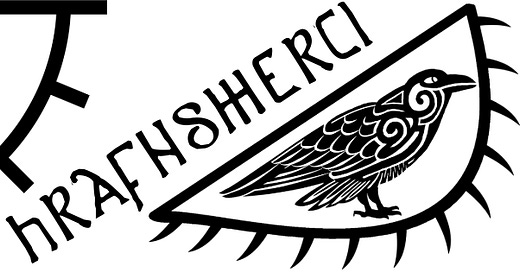“Hrafnar tveir sitja á öxlum honum ok segja í eyru honum öll tíðendi, þau er þeir sjá eða heyra. Þeir heita svá, Huginn ok Muninn. Þá sendir hann í dagan at fljúga um heim allan, ok koma þeir aftr at dögurðarmáli. Þar af verðr hann margra tíðenda víss. Því kalla menn hann Hrafnaguð, svá sem sagt er:
Huginn ok Muninn
fljúga hverjan dag
jörmungrund yfir;
óumk ek Hugin,
at hann aftr né komi,
þó sjáumk ek meir of Munin." - Snorri Sturluson (Prose Edda)
The passage above is taken from Snorri Sturlusson’s poem Gylfaginning ("The Beguiling of Gylfi"), which takes shape in the the form of a dialogue between a Swedish King Gylfi and three men on thrones in Asgard called High, Just-As-High, and Third - which is believed to be the three manifestations of Odin. Gylfi asks these beings many questions on the history and future of the Æsir (one branch of the Norse gods - the other being the Vanir). In this dialogue the creation and eventual destruction of the world are described, as are many other aspects of Norse mythology, including Odin’s ravens - Huginn and Muninn.
The passage translates as;
Two ravens sit on Odin's shoulders, and bring to his ears all that they hear and see. Their names are Huginn and Muninn. At dawn he sends them out to fly over the whole world, and they come back at breakfast time. Thus he gets information about many things, and hence he is called Rafnagud (raven-god). As is here said:
Huginn and Muninn
Fly every day
Over the great earth.
I fear for Hugin
That he may not return,
Yet more am I anxious for Munin - Snorri Sturluson (Prose Edda)
The raven is a common and symbolic bird in Norse mythology, specifically as one of the three battle animals alongside the wolf and the vulture. Ravens are often linked to death and war due to their preference for carrion, so they can always be seen around battlefields. Some regarded ravens as Valkyries, the goddesses who chose the more valiant dead to ascend to the hall of Valhalla. The ravens appear in almost every skaldic poem that mentions battle and warfare - to wage war was to feed the ravens. Despite the violent imagery associated with them, the early Scandinavians regarded ravens as a positive symbol of the divine, even if it was harsh justice.

The raven considered a symbol of Odin, and considering he decided the outcome of battles, it was important to have him on their side. Thus, for Viking warlords and chieftains the totemic raven banner was carried into battle from the 9th to the 11th centuries. While there has been no visual description of the raven banner, Norse artwork from the time depicts banners as being triangular with a rounded edge.
The banner was famously used by the sons of Ragnarr Loðbrók and the Great Heathen Army that invaded the British Isles in 865 - as revenge for the killing of their father in a snake pit by King Ælle of Northumbria. It was first mentioned in the Anglo-Saxon Chronicle (ASC) for the year 878;
“In the winter of the same year, the brother of Ivar and Halfdan landed in Devonshire, Wessex, with 23 ships, and he was killed there along with 800 other people and 40 of his soldiers. The war banner (guþfana) which they called "Raven" was also taken.” - ASC
It was said to have magical powers (seiðr) and was used by Ubbe at the Battle of Cynwit (878) in which he fell to Odda and the Devonshire fyrd.
In the 10th century it seems to have been adopted by the Norse-Gaelic kings of Dublin and Northumbria, who were members of the Uí Ímair clan - who were descendants of Ivarr the Boneless. It was also used by the Jarls of Orkney, and according to the Orkneyinga saga, it was made by the shamanic völva (seeress) mother of Sigurd the Stout. She told him that the banner would "bring victory to the man it's carried before, but death to the one who carries it."
In the 11th century it was used by King Cnut the Great of England, Norway and Denmark at Battle of Ashingdon in 1016. British shores saw the raven banner wielded by a Viking for the last time in 1066 at the Battle of Stamford Bridge - when Harald Hardrada flew his standard Landøyðan (Land-waster).
In modern times the raven is symbolically is still used in coats of arms of Shetland and the Isle of Man alongside the Norwegian intelligence agency. In the UK the banner with a gold field was used as the badge of the S48 Submarine HMS Conqueror. It is also used by Nordic Animist scholar Rune Hjarnø Rasmussen to champion environmental causes and how we can use animist values to reconnect with the earth and protect it.
Every time I see this banner I feel a small sense of dread, there is something mystical about it, and had I been a member of the Wessex fyrd in Devon at Cynwit, no doubt I would have feared my opponent. The raven is a striking bird when you see them, you can feel an air of mysticism around them, yet you feel eerily comforted as you know you are in the presence of the High One himself…





